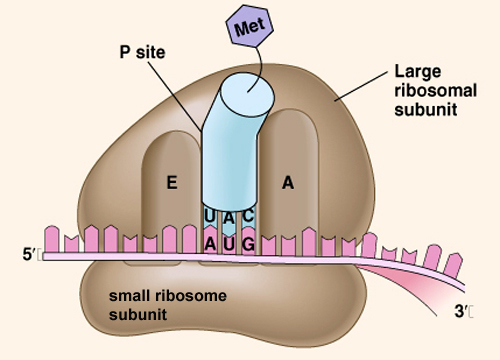 Structure of the 30S subunit from T.thermophilus Structure of the 50S subunit from D. radiodurans
Structure of the 30S subunit from T.thermophilus Structure of the 50S subunit from D. radiodurans
Introduction to a Ribosome
All living cells contain ribosomes and thus are found both in prokaryotic and eukaryotic cells. Ribosomes are composed of 60% ribosomal RNA (rRNA) and 40% proteins. They are not membrane bound molecules.Ribosomes are mainly found attached to the endoplasmic reticulum, the nuclear envelope and are freely distributed in the cytoplasm, depending upon whether the cell is eukaryotic or prokaryotic. They can also be found in organelles such as mitochondria and chloroplast. Ribosomes found in prokaryotic cells are smaller than those found in eukaryotic cells but have a similar function.A ribosome is a structure in the cell where protein synthesis occurs. Ribosomes use genetic information transported in ribonucleic acids to form proteins from amino acids. The size and amount of ribosomes varies. [11]
Structure of Ribosomes
Components of the Ribosome consist of two subunits:
Prokaryotic cells: Ribosome consists of two subunits of 30s and 50s size giving a total value of 70s.[8]
Eukaryotic cells: Ribosome consists of two subunits of 40s and 60s size giving a total value of 80s.[8]
Both types of ribosomes binding sites for tRNA [8]
tRNA: transfer RNA that transfers specific amino acid to a growing polypeptide chain at the ribosomal site of protein synthesis during the process of translation.
Translation: mRNA from the product of transcription is decoded or “translated” to a specific amino acid which will later become a protein. This process occurs in the cell’s cytoplasm. The ribosome decodes by binding tRNA with a complementary anticodon sequence of mRNA. The tRNAs then carry the amino acids that are chained together as the mRNA is passed through the ribosome and essentially “read” , or translated. The end result is active protein.[8]
DNA --->RNA --->Protein
DNA synthesis--->Transcription into mRNA--->Translated into protein by the Ribosome

Breakdown of the structure of the Ribosome
-2 subunits, 1 large and 1 small. Both subunits consist of one or more molecules of rRNA and an array of ribosomal proteins. When the two are associated together in a single ribosome the structure can be called a monosome.
rRNA: decodes mRNA into amino acids and interacts with tRNA by providing peptidyl transferase activity. tRNA brings the necessary amino acids to the appropriate mRNA codon. It is also the most abundant RNA in the cell
-Prokaryotic Larger subunit: 23S rRNA molecule, a 5S rRNA molecule and 31 ribosomal proteins. ( stabilizes the protein)
-Eukaryotic Larger subunit: 28S rRNA, 5.8S and 5S rRNA and 49 proteins.
-Prokaryotic Smaller subunit: 16S rRNA and 21 proteins.(It is important for the subunit association and translational accuracy as well as identification of bacteria.)
-Eukaryotic Smaller subunit: 18S rRNA and 33 proteins.
"The small subunit is responsible for the formation of the initiation complex, performs the decoding of the genetic information, and controls the fidelity of codon-anticodon interactions. The large subunit catalyzes the peptide bond formation and provides the path for the nascent polypeptide chain."[12]
“The small ribosomal subunit, typically bound to a tRNA containing the amino acid methionine, binds to an AUG codon on the mRNA and recruits the large ribosomal subunit. The ribosome then contains three RNA binding sites, designated A, P, and E”[8]
-3 RNA Binding sites: E, P, A
A site: binds an aminoacyl-tRNA (a tRNA bound to an amino acid)
P site: binds a peptidyl-tRNA (a tRNA bound to the peptide being synthesized)
E site: binds a free tRNA before it exits the ribosome [8]
Home Page Nobel prize winners Functions of the Ribosomes Significance of Ribosomes References